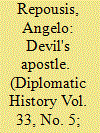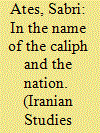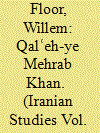|
|
|
Sort Order |
|
|
|
Items / Page
|
|
|
|
|
|
|
| Srl | Item |
| 1 |
ID:
091276


|
|
|
|
|
| Publication |
2009.
|
| Summary/Abstract |
On March 31 (April 12, new style) 1851, a twenty-year-old Greek medical student named Demetrius Demakes appeared before the Council of Inquest of the Court of Correctional Police in Athens to give a deposition in the case against the Reverend Dr. Jonas King, a Congregationalist Protestant American missionary-educator
|
|
|
|
|
|
|
|
|
|
|
|
|
|
|
|
| 2 |
ID:
133821


|
|
|
|
|
| Publication |
2014.
|
| Summary/Abstract |
Under the leadership of Sheikh Ubeidullah of Nehri, in the last months of 1880 tens of thousands of Iranian and Ottoman Kurds marched on northwestern Iran and temporarily took control of several cities. This movement, coupled with the response of the Iranian army, resulted in great violence and displacement. Despite its failure, in the limited literature on Kurds this revolt is seen as the birth of Kurdish nationalism. Using extensive and underutilized historical documents-including official correspondence from Iranian and Ottoman authorities as well as British consuls, and day-to-day reports and memoirs from American missionaries active in the region-this project suggests that Sultan Abdulhamid's (Sunni) pan-Islamist agenda, Shi'i-Sunni tensions, the rise of Armenian nationalism, and missionary activities in the region also played significant roles in the formation of this movement.
|
|
|
|
|
|
|
|
|
|
|
|
|
|
|
|
| 3 |
ID:
171088


|
|
|
|
|
| Summary/Abstract |
Before discussing the establishment and functioning of the first real leprosarium in Iran, a brief explanation is given of the pathology of leprosy, the various names are listed under which it was known in Persian, and the earliest archeological evidence of its occurrence is presented. Also, societal behavior in Imperial Iran towards lepers is highlighted, while reference is made to the earliest medical descriptions of leprosy in Persian. Little is known about the occurrence of leprosy in Iran over the centuries, as evidenced by the lack of knowledge about its prevalence among medical practitioners and institutions in Iran, even as late as the 1920s. Although segregated villages with lepers existed prior to 1926, it was only as of then that the Mehrab Khan village became the first true Iranian leprosarium, when regular institutional medical treatment was offered by American missionary physicians. The funding agencies, medical personnel and treatment, the living environment of lepers and their numbers in Mehrab Khan are discussed as well as how its population size and status changed over time, and how it was transformed into a structural component of public medical care. Finally and briefly, the establishment and functioning of two other Iranian leprosaria is discussed as well as the slow but sure disappearance of the disease in Iran.
|
|
|
|
|
|
|
|
|
|
|
|
|
|
|
|
| 4 |
ID:
168817


|
|
|
|
|
| Summary/Abstract |
This article investigates Dalits’ dreams and desires for education in the United Provinces by examining hitherto unexplored records of the American Methodist Church missionaries and the Arya Samaj from the late nineteenth and early twentieth centuries. Focussed on the schools opened for Dalits and Dalit Christian converts by these two religious organisations, it explores the schools’ visions and objectives. The article presents the history of Dalit education beyond the existing dominant analytical frame of educational access and exclusion. It suggests that the mere inclusion of marginalised groups in educational institutions did not guarantee equality; rather, inclusion set in train a process for producing newer forms of exclusion, inequality and suppression. I argue that while these schools opened an important window for Dalit education in the region, the education offered was limited, hierarchical and practical. Both Christian missionaries and Arya Samajis saw Dalits primarily as a labouring community, and the education they offered reflected this thinking; it aimed at making Dalits productive, disciplined and loyal beings. Nevertheless, this limited education allowed Dalits to dream of a literate and dignified life and to pursue non-manual labouring careers.
|
|
|
|
|
|
|
|
|
|
|
|
|
|
|
|
| 5 |
ID:
179071


|
|
|
|
|
| Summary/Abstract |
On a summer day in 1935, James Gordon Holdcroft, an American Presbyterian missionary in colonial Korea, hurried to the Educational Bureau of the Government-General. He had an urgent meeting with its chief, Watanabe Toyohiko, to discuss the recent change of tone in the government’s educational policy, which mandated all students without exception to salute at the shrines of State Shinto. Believing that such a ritual marked no ordinary gesture of respect for fallen soldiers but an act of pagan worship honoring spirits, Holdcroft found the policy hard to accept for mission schools. Deeply troubled about its consequences, he hoped to hear from the authorities more about the matter. At the bureau, after the usual welcoming remarks, the educational chief reassured him that mission schools would be exempted from any rite that could offend Christians. Holdcroft felt relieved and returned to his office.1 Yet in late fall, he realized that Watanabe’s promise failed to materialize. Mission schools received orders from the government to participate in shrine ceremonies. Holdcroft’s fear came true.
|
|
|
|
|
|
|
|
|
|
|
|
|
|
|
|
|
|
|
|
|